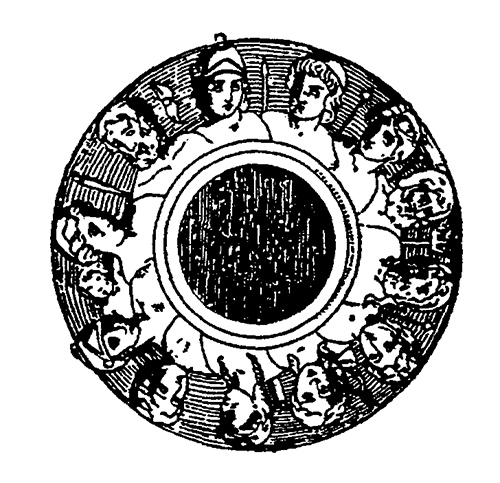Man is unable to comprehend eternity in any other sense than that of a circle. The greatest god of all the old pantheons always represented Time, and he was the father of all the other gods. He carried in his hand a straight line and a circle. The first had beginning and end, the second neither. This represented Time and Eternity. The straight line divided into 12 equal parts also represented Matter. From it was constructed the greater cosmic triangle of 3, 4, and 5 parts, the foundation of all geometrical science.
The solar universe, constituting a. stupendous clock, keeping more perfect time, in the divinely adjusted revolutions of all its parts, than the most perfect chronometer of human workmanship, naturally conveys the notion of periodic time and also furnishes the means for its measurement, in the circular courses of the planets round the great dial of the ecliptic . The almost circular but still elliptical course of the earth round the sun supplies the means of measuring the course of the year, with its series of identical, ever-recurring phenomena, upon which the whole course of human life is based.
The division of this year-circle into 12 equal parts is one of the pillars of geometry, as its further section into 360 is of mathematics. Neither is an arbitrary process, but each is founded on fixed natural principles.
Read: God and Freemasonry
The allegory of King Solomon’s Temple so closely parallel, upon real historical happenings to a material edifice, was that of the fruitful year, with its bountiful harvest and various other blessings, scarcely erected and dedicated ere falling into destruction and decay.
The story of the annual building of the Temple, its destruction and restoration in three days, the untimely loss of its chief architect and of his miraculous revival for the purpose of continuing his labors, is the theme of legends as old as the Pyramids, if not older, and has been told in many different ways to various races and ages.
Strange to say, they do not transpire in the biblical account of the building of King Solomon’s Temple. Our first trace of them is away back in old Babylonia where a mystery drama was performed by the priests, showing the adventures of a mythical hero, sometimes called Gilgamesh and sometimes Izdubar, who was slain and revived at the winter solstice. This was when the winter solstice was in Pisces, and so the hierophants were dressed as fish and were surrounded by 10 other figures wearing animal heads as masks representatives of the months. The hero was of course the month of the Ram, making 12 in all. The story of Joseph and his brethren is a beautiful rendition of this universal mystery drama.
Read: Great Architect of the Universe – Symbols and Symbolism
The Hebrews never discarded the profound scientific knowledge of their Chaldean ancestors, but diverted it from the idolatrous misuses into which it had fallen, doing away with the idea of gods as month representatives for that of patriarchs, worshipers of the one true God of Israel.
The whole scheme was undoubtedly what we should now call astrological. Men were supposed to derive their qualities from the celestial powers, as indicated by the relative positions of the planets at the time they were born, and indeed the world only generally discarded this notion a few hundred years since, while many still find it a serious contemplation.
When Joshua led the victorious Israelites across the Jordan, upon their entrance into the Promised Land he selected a representative of each tribe as the bearer of a stone, afterward erected as a memorial at a place called “Gilgal.” This name is the term now given by savants to all such stone circles found throughout the Orient, and as they are frequent it shows that a ceremonial in honor of the year was common in the East and that the ritualistic stations were 12 in number, hierophants representing the sun, moon, and planets performing what we should term the “floor work.”
These ceremonies spread to the West, and were the basis of Druidism. The 12-stone circles remain in many parts of Europe. The stories of Samson and Hercules are founded on them. Elijah erected one of these circles, in the midst of which he placed his sun altar when he confuted the priests of Baal.
We find the number 12 predominating in all the arrangements of the Israelites. Twelve oxen supported the great laver in King Solomon’s Temple, and 12 lions led to his throne. The selection of 12 apostles was in obedience to this most ancient of traditions.
There were three other fellow crafts associated with the age-old mystery play; but they were not month signs; they were the three winter planets, Mars, Jupiter, and Saturn. The twelve worthy brethren really got along very well in life because the Greeks and Romans were so well pleased with their performances that they promoted them to be the gods of Olympus.

Contents – The Beginning of Masonry
Previous – Our Three Grand Masters
Next – The Cable Tow
